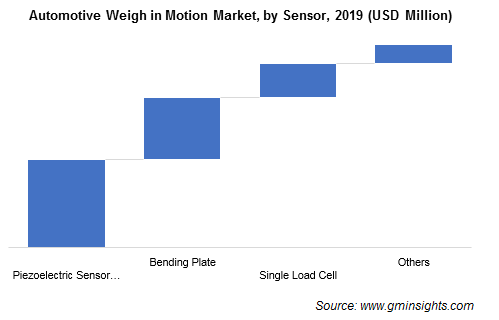Automotive Weigh in Motion System Market worth over $2.98bn by 2026
Published Date: May 2020
Automotive Weigh in Motion System Market size is set to exceed USD 2.98 billion by 2026, according to a new research report by Global Market Insights Inc.
Increasing traffic congestion issues to result in an increased demand of automotive weigh in motion system
WIM systems are majorly installed in highways and tolls to detect overloaded vehicles and for reducing traffic congestion. Real time analysis and monitoring of traffic assists in optimizing traffic movement. WIM systems have the ability to deliver traffic information without disrupting any traffic flow. These systems can be installed on any specific location permanently to monitor traffic or in case of bridge WIM systems, it can also be moved from one site to another to capture traffic data. Detailed traffic information provided by automotive weigh in motion systems also gives quite important input for transportation studies as well.
Global automotive weigh in motion system market is expected to achieve high growth rate during the forecast period. However, the demand will be on a lower side in the year 2020 due to COVID 19 impact on various high growth regions. Europe which is the largest market for this technology is highly impacted by COVID 19 and hence automotive production, sales and the whole transportation industry is getting a hit which in turn has resulted in a reduced demand for the region.

Get more details on this report - Request Free Sample PDF
Bending plates to gain a significant market share in the coming years
Bending plate has emerged as one of the most accurate weigh in motion technologies and will account for over 30% share by 2026, the technology can produce most accurate data when maintenance is done properly with time. These types of sensors are comparatively durable from other alternatives lasting for about eight to twelve years. Bending plate sensors provide an accuracy of over 3%. However, as the accuracy is high in these sensors, the cost is also slightly higher than piezo quartz sensors. Bending plate is generally recommended to be used in a wide range of applications including prescreening, weight enforcement, bridge and highway design etc.
Browse key industry insights spread across 142 pages with 151 market data tables & 12 figures & charts from the report, “Automotive Weigh in Motion System Market Size By Sensor (Piezoelectric Sensor, Bending Plate, Single Load Cell), By Installation (In-Road System, Weigh Bridge System, On Board Weighing), By Application (Traffic Data Collection, Weigh Enforcement, Weigh Based Trolling, Bridge Protection, Industrial Truck Weighing), By Speed (Low Speed, High Speed), Industry Analysis Report, Regional Outlook, Application Potential, Price Trends, Competitive Market Share & Forecast, 2020 – 2026” in detail along with the table of contents: https://www.gminsights.com/industry-analysis/automotive-weigh-in-motion-market
On road WIM systems to follow a consistent growth trend in near future
On road weighing installation segment will witness gains of over 7% from 2020 to 2026 impelled by stringent government regulations to achieve maximum road safety. On road WIM systems (OBW) are installed on vehicles rather than on roads or highways. This system measures the axles, gross, wheel loads, vehicle length, transverse location, speed of vehicle in dynamics state. OBW systems are used in commercial vehicle to monitor the overloading status of vehicle and compliance with government regulations of weight enforcement.
Industrial truck weighing application to gain a large automotive weigh in motion system market share
Industrial truck weighing is one of the major applications areas of weigh in motion systems. Heavily loaded trucks are a major cause of increasing pavement wear, premature pavement failing and increased maintenance cost, as various truck combinations carry heavy loads by adding extra axles. Automotive weigh in motion systems provides data for these heavy trucks to plan possible transportation routes to these trucks. The technology helps in avoiding damage to bridges and highways, increase road safety as well reduce maintenance cost.
High speed systems to gain momentum in coming years
High speed WIM systems refer to technology where weighing is practiced in open traffic in a complete free flow condition. The measurement is affected by vehicle dynamics which again depends on various factors such as geometry of road pavement in WIM site, disturbance to movement of vehicle etc. However, there are other factors too which impact measurement of weigh in motion systems such as configuration, type and number of sensors installed in one site. These systems have an accuracy of over 5% to 10%. Although more or less accurate systems are available in the industry. However, these systems will account for over 25% demand share in 2026 due to increasing investment by industry players to improve the accuracy of the data generated by high speed systems.
High growth prospect in Asia Pacific
Asia Pacific is set to achieve high growth in automotive weigh in motion system market on account increasing traffic congestion issues in various developing countries. However, the industry will witness a fall in demand in the year 2020 amid COVID19 impact on many countries in the region. The demand is expected to gain momentum as soon as the region overcomes the global pandemic. Furthermore, strict government regulation coupled with increasing commercial vehicle sales is expected to remain the key contributor to demand in the region till 2026.
Innovative business solutions to increase industry rivalry
In February 2018, Kistler showcased its Ki traffic weigh in motion system technology in Amsterdam, which helps authorities and road owners in weight enforcement, traffic monitoring, and in many other applications. This steps aims to increase awareness among key consumers regarding use and implementation of intelligent transport systems.





